The Love Triangle Spread
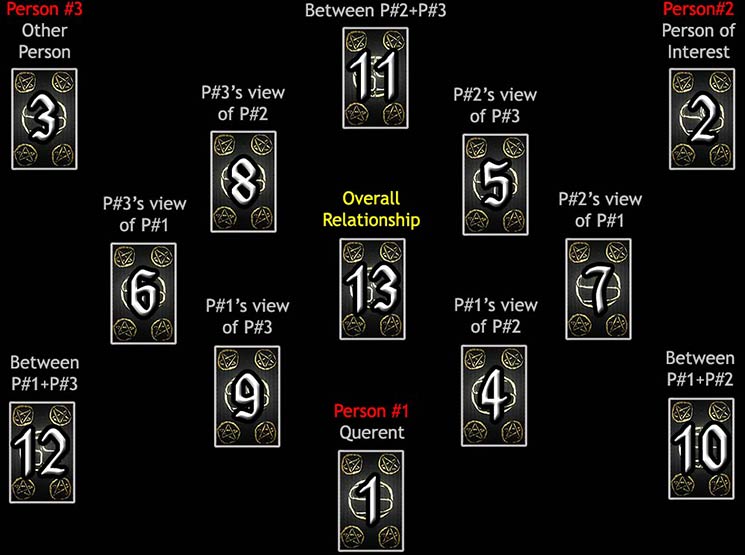
Difficulty: Complicated
Casually referred to as the Love Triangle, this spread can be used to determine the dynamics of the relationship between three people, regardless of whether romance is involved. This spread is arranged in the form of a hexagram, consisting of several large and small triangles. This tarot spread may seem somewhat complicated, but it is not entirely that difficult.
The first step is to interpret the card for each individual position in the spread. Generally, one might ask about a relationship they are involved in, but this does not have to be the case. Ordinarily, the reader's representative card is #1, their main person of interest is #2, and the other person would be #3.
The second step fills in the downward triangle and involves further examination of the individuals through their views of the other people. Each person has two more cards showing the way they see and relate to the other members of the triangle. For example, Card #6 indicates how Person #3 relates to Person #1, while Card #9 stands for Person #1's attitude toward Person #3.
The next step completes the upward triangle and the hexagram, focusing on cards #10–13. It also completes the many smaller triangles and hints at the potential for each relationship. The final card, #13 can be considered the significator of the reading, which suggests the overall potential for this three-way relationship.
Your Love Triangle Reading
| P#3 | 3to2 | 2+3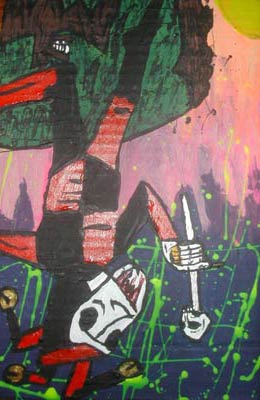 |
2to3 | P#2 | ||
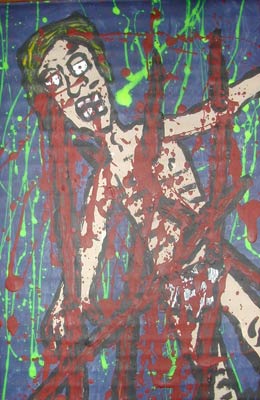 |
3to1 | 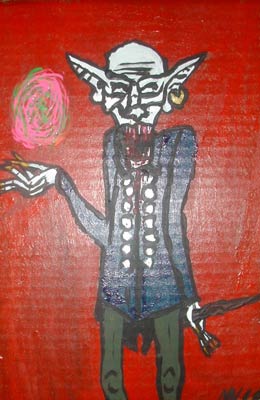 |
Overall | 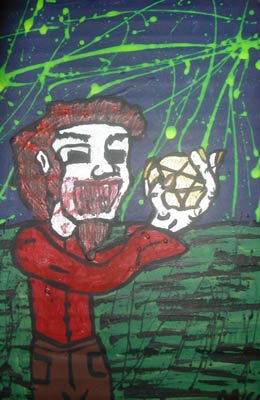 |
2to1 | 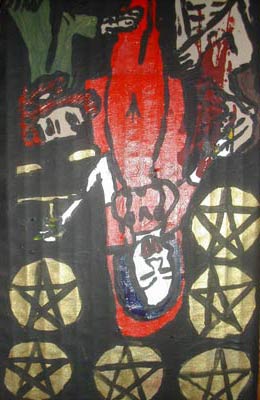 |
| 1+3 | 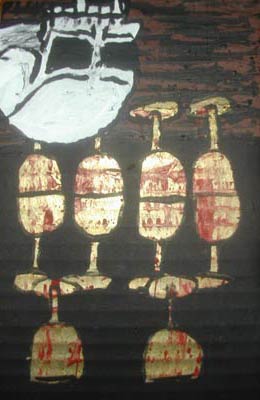 |
1to3 | 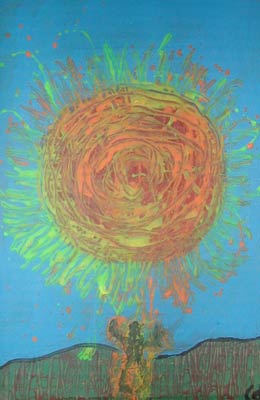 |
1to2 | 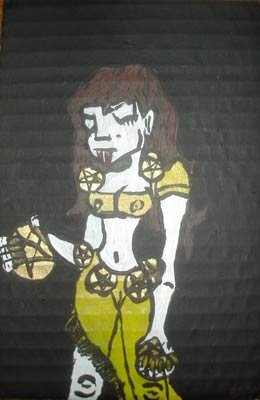 |
1+2 |
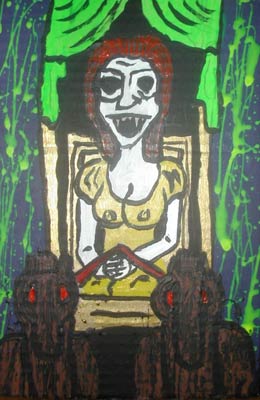 |
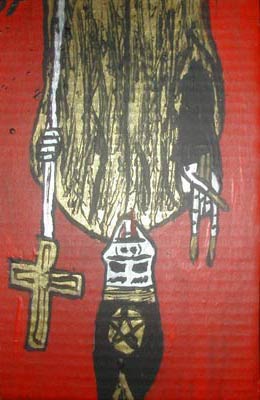 |
P#1 | 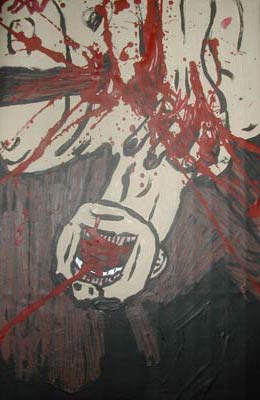 |
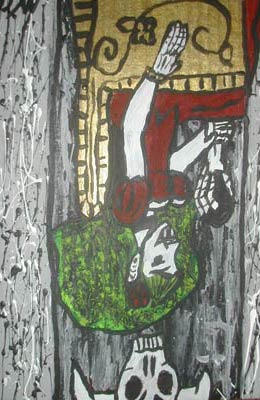 |
||
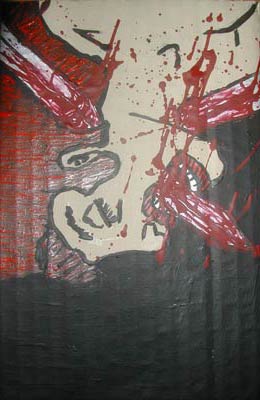 |
1: Person #1

Reversed
Symbolism:
A sword protrudes from the mouth of a female, symbolizing a smooth talker or someone who has the ability to communicate forcefully.
Meaning:
The Two of Swords represents difficult decisions, indecision, and mental conflict. It suggests being at a crossroads, where a choice must be made, but there is uncertainty or unwillingness to make it. This card symbolizes balance and the need to weigh options carefully.
When reversed, it indicates dishonesty, manipulation, or a refusal to face the truth. It can also suggest that the choice has been made, but with negative consequences such as betrayal or deception.
Keywords:
Reversed: Betrayal, deceit, falsehood, avoidance.
2: Person #2

Reversed
Symbolism:Two men beg a seductive vampire, one drained, the other eager for his turn. This scene represents generosity, power dynamics, and the exchange of resources—both material and emotional.
Meaning:
The Six of Pentagrams signifies giving and receiving, with a focus on generosity and balance in exchanges. It may indicate a time when you are helping others or receiving aid, and it highlights the importance of fairness and reciprocity. It suggests prosperity through kindness, vigilance, and prudence.
Reversed, it suggests imbalance or exploitation in relationships. It may point to envy, rivalry, or one-sided exchanges where one party feels drained or exploited.
Keywords:
Reversed: Exploitation, imbalance, envy, rivalry, one-sidedness.
3: Person #3

Symbolism:
A man trapped in a pit, impaled by five stakes, fights against overwhelming odds. The struggle is real and relentless, representing competition, ambition, and the challenges faced in the pursuit of success. His tattered state hints at the toll such pursuits can take on one's spirit.
Meaning:
The Five of Stakes represents conflict, rivalry, and the test of one's determination. It reflects the spirited competition and the drive to rise above challenges. While the fight may be strenuous, it also forges resilience and sharpens your focus. This card encourages perseverance despite obstacles.
Keywords:
Upright: Competition, rivalry, ambition, perseverance, resilience.
4: Person #1's view of #2

Reversed
Symbolism:
A vampire spews forth the life force he has consumed, a dramatic display of surprise and chaotic energy. The heart, pierced by a stake, symbolizes duality—an ending and a new possibility, the destruction of one path to illuminate another. The overflowing energy represents the unpredictability of partnership and cooperation.
Meaning:
The Two of Stakes signals a crossroads where choices must be made. It is a card of balance and partnership, representing the potential for collaboration or conflict. This card urges careful consideration and planning before proceeding, as your choices now will shape your future path. It can signify unexpected surprises, wonder, and a touch of enchantment that transforms your perspective.
Reversed, the card warns of discord, minor disappointments, or fear of moving forward. It may reflect internal struggles or external obstacles disrupting harmony.
Keywords:
Reversed: Conflict, disappointment, delays, fear, internal struggle.
5: Person #2's view of #3

Symbolism:
A young man clasps a pentagram, recognizing that he holds the power to shape his own destiny. This card represents potential and the beginning of a journey towards material or intellectual success.
Meaning:
The Page of Pentagrams signifies learning, new beginnings, and opportunities to grow. It points to a time when you are focused on laying the groundwork for future success. This card encourages you to be practical and take small, deliberate steps toward your goals.
Keywords:
Upright: Learning, potential, opportunities, practicality, new beginnings.
6: Person #3's view of #1

Reversed
Symbolism:
Ten used cups sit in storage, while a skull watches over them. The imagery suggests a sense of completion, fulfillment, and the closing of a chapter, but also a reminder that all things come to an end.
Meaning:
The Ten of Cups represents emotional fulfillment, contentment, and happiness in relationships. It is the ultimate expression of emotional satisfaction, often symbolizing harmony in family life, long-lasting love, or the completion of an emotional journey. It suggests a sense of peace and joy, where all emotions align, and dreams come true.
Reversed, this card warns of emotional disconnection or the end of a previously harmonious situation. It may indicate broken relationships, family conflicts, or feelings of dissatisfaction despite outward appearances.
Keywords:
Reversed: Disconnection, broken relationships, emotional dissatisfaction, family conflicts.
7: Person #2's view of #1

Symbolism:
An exotic dancer adorned in pentagrams performs, her act representing craftsmanship and skill. She embodies the dedication to her craft, with a focus on discipline and mastery.
Meaning:
The Eight of Pentagrams speaks to hard work, craftsmanship, and the pursuit of excellence. It suggests a time of preparation and dedication to one's skills. Whether in a professional or personal capacity, this card encourages you to continue honing your abilities and remain committed to your goals.
Keywords:
Upright: Craftsmanship, dedication, skill, preparation, hard work.
8: Person #3's view of #2

Symbolism:
The Magician is depicted as a Nosferatu vampire standing in a commanding pose, a sphere of influence hovering above his outstretched hand. This sphere glows with an otherworldly light, symbolizing his power to manipulate unseen forces. His posture exudes confidence, and the tools of his craft—representing the elements—are subtly embedded in the imagery, hinting at his mastery over earth, air, fire, and water. The shadows around him pulse with potential, representing untapped energy and possibility.
Meaning:
The Magician embodies willpower, creativity, and the ability to manifest one's desires. He is the ultimate initiator, reminding you that you have the power within to transform ideas into reality. This card urges action and focus, calling upon the seeker to harness their innate talents and take charge of their destiny. In situations requiring ingenuity or problem-solving, the Magician assures you that all the tools you need are at your disposal.
Keywords:
Upright: Initiative, willpower, manifestation, skill, confidence, resourcefulness, creation.
9: Person #1's view of #3

Reversed
Symbolism:
The Hierophant stands in a candlelit crypt, robed in dark ceremonial attire. His face is obscured by a mask resembling a skull, emphasizing his role as a mediator between the living and the dead. In his hands, he holds an ancient grimoire, its pages glowing faintly as if infused with sacred knowledge. Behind him, shadowy figures bow in reverence, symbolizing tradition and the transfer of esoteric teachings.
Meaning:
The Hierophant represents tradition, spiritual guidance, and conformity to established systems of belief. He serves as a bridge between the divine and the mundane, reminding you to honor time-tested wisdom and moral values. This card often calls for introspection about your relationship with tradition and how it shapes your choices. It may also suggest seeking counsel or mentorship from someone with greater experience or spiritual authority.
Reversed, the Hierophant challenges the rigidity of traditions, encouraging independent thought and nonconformity. It warns against blind faith in systems that may no longer serve you.
Keywords:
Reversed: Nonconformity, rebellion, outdated beliefs, spiritual doubt, dogmatism.
10: Overall relationship between persons #1 and #2

Reversed
Symbolism:
The Empress sits upon her throne, her presence commanding yet nurturing. She holds the Hand of Glory, a macabre artifact symbolizing her power to claim whatever she desires. Her surroundings are lush and fertile, with dark roses blooming amidst the decay—symbols of beauty and abundance arising from even the grimmest conditions. Her expression is one of calm authority, radiating life-giving energy.
Meaning:
The Empress represents creation, fertility, and the nurturing aspects of life. She signifies abundance and the ability to bring ideas, projects, or relationships to fruition. This card invites you to connect with your creative or maternal instincts and embrace the cycles of growth and renewal. It may also point to emotional or physical abundance and a celebration of life's pleasures.
Reversed, the Empress warns of stagnation, overbearing tendencies, or emotional imbalance. It may point to neglect, smothering, or difficulties in manifesting creativity.
Keywords:
Reversed: Stagnation, neglect, overbearing, creative block, emotional imbalance.
11: Overall relationship between persons #2 and #3

Reversed
Symbolism:
The Fool is depicted as a pale, ethereal figure walking a misty, crumbling path, a bundle tied to a staff slung over their shoulder. They gaze skyward, unaware of the jagged cliff at their feet. A spectral wolf follows close behind, snarling a silent warning. Overhead, a full moon illuminates their journey, hinting at the mystery and potential of new beginnings. In their hand, a delicate white rose symbolizes innocence and purity.
Meaning:
The Fool represents beginnings, spontaneity, and boundless potential. It urges you to take a leap of faith, trusting in the journey ahead. While the path may be uncertain, embracing the unknown opens the door to growth, discovery, and self-expression.
Reversed, the Fool warns of recklessness, naivety, or hesitation. It suggests the need to pause and consider potential consequences before plunging ahead.
Keywords:
Reversed: Recklessness, foolishness, naivety, hesitation, fear of the unknown, poor judgment.
12: Overall relationship between persons #1 and #3

Symbolism:
The Chariot is a sinister yet majestic vehicle drawn by two spectral horses, one black and one white, representing opposing forces. A Nosferatu figure stands at its helm, cloaked in shadows, holding a whip of shadowy tendrils. The chariot races through a mist-laden nightscape, its wheels crushing fallen leaves and brittle bones, symbolizing the journey's sacrifices and challenges.
Meaning:
The Chariot signifies determination, control, and the will to overcome obstacles. It calls for focused effort and harnessing conflicting energies to achieve a goal. This card often appears when decisive action and self-discipline are needed to navigate a complex situation. It encourages you to take charge of your direction and steer with purpose.
Keywords:
Upright: Determination, control, focus, discipline, willpower, triumph, direction.
13: Overall 3-way Relationship

Symbolism:
The Sun features a radiant figure standing atop a stone altar, their outstretched arms ablaze with golden light. Behind them, a massive blood-red sun dominates the sky, casting warm, revitalizing rays over a once-shadowed landscape. Sunflowers bloom vibrantly in the foreground, representing vitality and joy. A golden wolf stands beside the figure, symbolizing loyalty and enlightenment.
Meaning:
The Sun represents joy, success, and clarity. It heralds a period of positivity, growth, and accomplishment, reminding you to embrace life with enthusiasm and gratitude. This card suggests that challenges are behind you, and a brighter path lies ahead.
Keywords:
Upright: Joy, success, clarity, vitality, growth, positivity, accomplishment.
